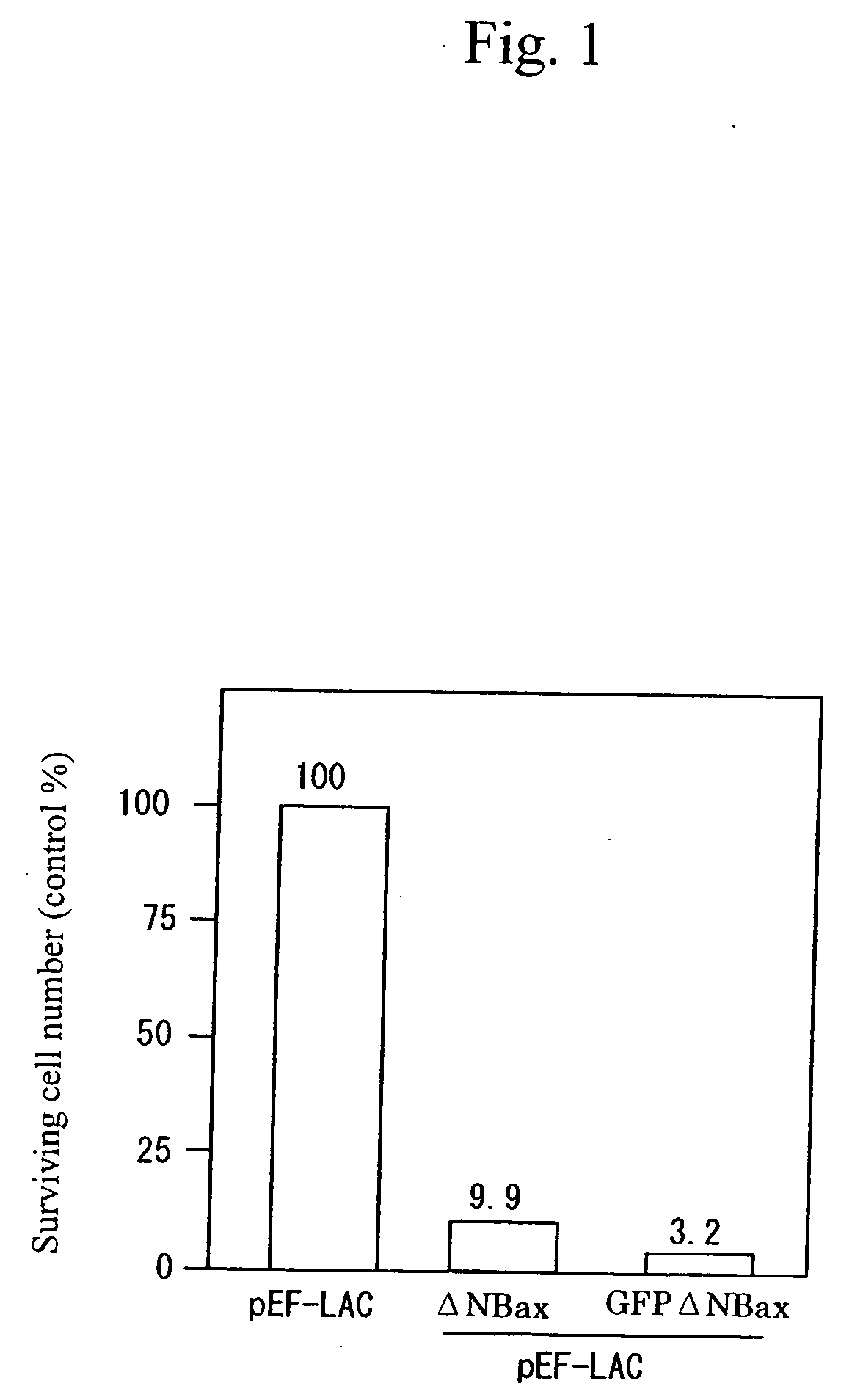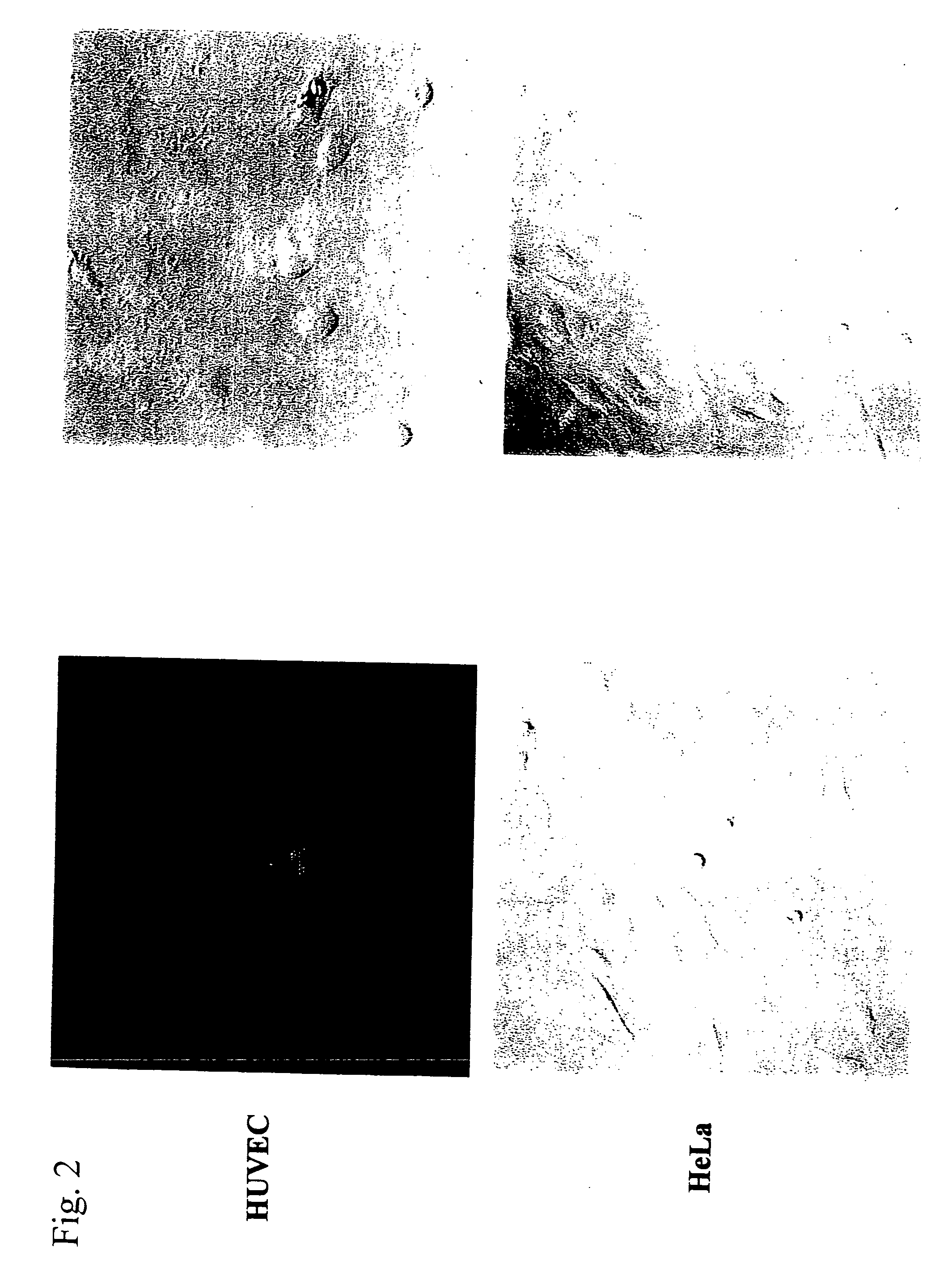Cell death-inducing fused gene acting specifically on cancer and gene product thereof
a cell death and fused gene technology, applied in the field of protein having a strong cell death-inducing activity, can solve the problems of immunotherapy that requires a long time and further, many problematic side effects, and requires great development efforts, and achieves the effect of enhancing the cell death-inducing activity
- Summary
- Abstract
- Description
- Claims
- Application Information
AI Technical Summary
Benefits of technology
Problems solved by technology
Method used
Image
Examples
example 1
Construction of GFP-ΔNBax
(1) Construction of GFP-ΔNBax
[0087] The GFP (Green Fluorescent Protein) gene (DNA fragment A) and the ΔNBax gene (DNA fragment B) were linked by the two-step PCR method.
[0088] DNA fragment A was amplified using a 5′-end primer (Primer 1) and 3′-end primer (Primer 2) and pGreenlantern (Invitrogen LifeTechnology) as a template. The 3′-half of Primer 1 contains the nucleotide sequence of the sense strand from the initiation codon of the GFP gene, and there is a restriction site (ATCGAT) of restriction enzyme ClaI at the 5′-end of the primer. The 5′-half of Primer 2 contains the anti-sense sequence of the 5′-end of the ΔNBax gene (from Ala 112 to Ser 118) and is complementary to Primer 3. Also, the 3′-half of the primer has an anti-sense nucleotide sequence of the 3′-end of the GFP gene except the termination codon.
[0089] DNA fragment B was amplified using a combination of Primer 3 and Primer 4 and pEF1BOS-Bax (Biochem Biophys Res Commun. 1998 Feb. 13; 243 ...
example 2
Construction of RGD-GFP-ΔNBax and NGR-GFP-ΔNBax
[0107] To link a homing signal sequence specific to endothelial cells (RGD and NGR) to the 5′-end of the GFP-ΔNBax fusion gene, an E. coli expression vector, pPROEX1 (Invitrogen Life Technology), was used. The vector pEF-LACAB and the GFP gene (nucleotide 166) in the GFP-ΔNBax fusion gene have 3 and 1 NcoI restriction sites, respectively. pEF-LACAB / GFP-ΔNBax was cleaved into 4 DNA fragments by NcoI, and the DNA fragment with about 1.3 kb long, which contains the 794-bp-long 3′-region (NcoI-XbaI) of the GFP-ΔNBax fusion gene (total length 980 bp), was cloned at the NcoI site of pPROEX1 in the right orientation to obtain pPROEX1 / ΔNGFP-ΔNBax. Two NotI restriction sites are present in the sequence derived from pEF-LACAB (7 bp downstream of the XbaI site) and in the sequence of the vector pROEX1 at the downstream of 3′-end of cloned fragment (the NcoI site at the 3′-end). pPROEX1 / ΔNGFP-ΔNBax is cleaved with Not I to remove the sequence deri...
example 3
Subcloning of the RGD-GFP-ΔNBax Gene and the NGR-GFP-ΔNBax Gene into pIVEX2.2bNde and Production of these Gene Products in a Cell Free Protein Synthesis System
[0114] To produce NGR-GFP-ΔNBax and RGD-GFP-ΔNBax in a cell free protein synthesis system, these genes were subcloned to a plasmid vector pIVEX2. 2bNde (Roche). The method for subcloning of the genes consisted of 2 steps using NcoI sites in the GFP gene as in Example 2.
[0115] pPROEX1 / NGR-GFP-ΔNBax / NotI was cleaved with NcoI and XhoI, and a 822-bp DNA fragment containing the 794 bp-long 3′-region of the GFP-ΔNBax fusion gene (total length 960 bp) was recovered. This DNA fragment was cloned to the vector pIVEX2.2bNde cleaved with NcoI and XhoI beforehand to obtain pIVEX2. 2bNde / ΔNGFP-ΔNBax.
[0116] As in Example 2, the 206-bp NcoI DNA fragments of the NGR-GFP and RGD-GFP genes were amplified by the PCR method using pPROEX1 / NGR-GFP-ΔNBax / ΔNotI and pPROEX1 / RGD-GFP-ΔNBax / ΔNotI as templates, respectively. After recovering the DNA f...
PUM
| Property | Measurement | Unit |
|---|---|---|
| Length | aaaaa | aaaaa |
| Cell death | aaaaa | aaaaa |
| Cell growth | aaaaa | aaaaa |
Abstract
Description
Claims
Application Information
 Login to View More
Login to View More - R&D
- Intellectual Property
- Life Sciences
- Materials
- Tech Scout
- Unparalleled Data Quality
- Higher Quality Content
- 60% Fewer Hallucinations
Browse by: Latest US Patents, China's latest patents, Technical Efficacy Thesaurus, Application Domain, Technology Topic, Popular Technical Reports.
© 2025 PatSnap. All rights reserved.Legal|Privacy policy|Modern Slavery Act Transparency Statement|Sitemap|About US| Contact US: help@patsnap.com



